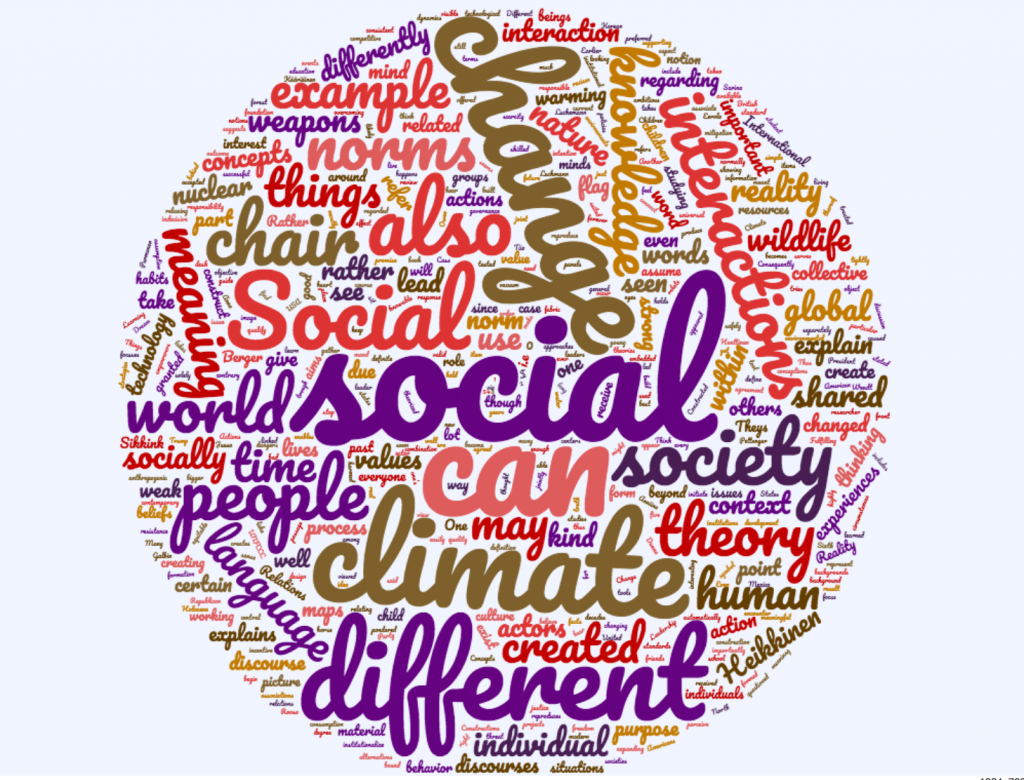 As part of their studies, first year students in the Leadership for Change Master’s Programme are writing short memos on various social theories. We are publishing some of the memos here, on the LFC blog. This set of memos deals with constructionism.
As part of their studies, first year students in the Leadership for Change Master’s Programme are writing short memos on various social theories. We are publishing some of the memos here, on the LFC blog. This set of memos deals with constructionism.
Going beyond institutionalized perceptions of the world
Tiia Eerola
Have you ever pondered the meaning of a chair, or how we take its purpose for granted? Think about it; we automatically assume that the chair is something that we sit on. However, children may consider its purpose completely differently, because they have not learned its institutionalized purpose. The phenomenon of how the meaning of the chair has emerged and is maintained is something that is examined through social constructionism.
What is social constructionism? It is a theory that originates from social sciences and sociology of knowledge, where things that are taken for granted are explored and questioned. A social constructionist theory examines how meanings are created in societies and maintained within social human interaction, where it is believed that social reality is not independent of its actors (Heikkinen, 2014). In other words, even though all knowledge is socially constructed, individuals can have different meanings for certain events and items, such as the chair.
 A chair in the forest may refer to relaxation and an ergonomic chair in front of a desk may lead us to a working mood. However, our perceptions of the chair are dependable on our past experiences and social human interactions. This relates to the notions of weak and strong constructionism, which were introduced during Anna Heikkinen’s lecture.
A chair in the forest may refer to relaxation and an ergonomic chair in front of a desk may lead us to a working mood. However, our perceptions of the chair are dependable on our past experiences and social human interactions. This relates to the notions of weak and strong constructionism, which were introduced during Anna Heikkinen’s lecture.
According to Heikkinen, the researchers who apply the weak constructionism perspective, believe that there can be different understandings over objective facts. On the contrary, strong constructionism includes the assumption that all knowledge is constructed by the society in social human interaction. However, there are also indecisive researchers, who are in between of the weak and strong perspectives.
When expanding this thought from a simple item – the chair – into something more complex, the social constructionism theory is tested further. If we consider the society around us, there are many dangers to humankind, for example, global warming and water scarcity. Such environmental issues can also be considered socially constructed (Heikkinen, 2014): their meaning is not discovered but constructed. For instance, global warming was not a problem before it was identified as such. In other words, multiple social realities can exist, which are dependable on the people who construct them, the time and the context. In research, social constructionism can be applied to discover these alternative meanings, which can lead to changes in people’s perceptions.
How does this relate to change? Global warming is highly connected with contemporary manufacturing and consumption habits, which have been social constructed over time. They cannot be changed before overcoming the resistance to change and providing alternatives for current institutionalized perceptions and habits.
Social constructionist research can make the alternative meanings visible, because the theory is all about looking beyond institutionalized perceptions. Therefore, social constructionism can lead to change by pinpointing issue that could be understood differently.
* * *
Social constructionism explaining the world
Roosa Purmonen
Nature and wildlife have such an important meaning in our lives. Many people would even say that they are one of the most important things in their lives.

But why is it, at the same time, that humankind had destroyed so much of nature? We are living in an era of Holocene extinction which is also referred to as the Sixth Extinction. What distinguishes it from the previous extinctions is that this one is caused by human actions. Even though we seem to value nature and wildlife why we are still destroying it so effectively?
People’s relation to the nature and wildlife is socially constructed. In other words, it cannot be stated unequivocally what one’s relationship with nature and wildlife is since everyone has a different relationship to them. Nevertheless, studying the relationship from the perspective of social constructionism can give us some explanations.
Social constructionism, as a theory of understanding the world, can be used to try to understand and explain the world. One of the explanations could be that people have constructed different meanings of it. People value it differently. Nature can be seen something we have a right to take advantage of, something that will give us resources and somehow serves our purposes. This kind of thinking has led to a situation where humankind has harmed nature and wildlife permanently and irreversibly. To be able to stop the exploitation and understand the frugality of the resources we need to change the way we think and see.
One of the issues social constructionism can explain is why things can receive different meanings in different situations. Social interaction has a role in meaning-making – in how we form and explain things in our minds. It tries to explain why things are the way they are in a social context. Galbin (2014) explains social constructionism in the form of maps. We all have ‘our maps’ of this world. They are different, yet they represent the same world. Social constructionism does not create the maps or take interest in creating them. Rather, it focuses on how they are formed. Social constructionism takes place in and through the language we use.
Constructionism is tightly linked with with International Relations constructivism. Sarina Theys (2018) explains constructivism in international relations referring to Alexander Wendt’s discussion of nuclear weapons. Why is it that Americans feel more threatened by the five North Korean nuclear weapons than the 500 British nuclear weapons? According to Wendt, the threat is not created by the nuclear weapons themselves (i.e., material structure) but how we see and perceive the material structure (i.e., ideational structure). Nuclear weapons do not have a meaning without their social context. How we see them is created in social context and in our minds. Theys explains that these meanings are under constant change and therefore they can change and be changed over time.
* * *
Social Constructionism in a Nutshell
Khalil Mozaffari
Social constructionist theory is not about discovering truth. It is not about judging what is good or bad. Instead, it is about how our different perceptions towards the world are shaped in the society we live through culture, language and interactions we have with others.

To begin with, whenever we hear a word, each one of us is likely to pictures the word in our mind and imagination differently than others. As an example, hearing the word ‘’lake’’, the imaginary picture each of us has in our mind is probably completely different. This is not only due to the different lakes we have seen in our lives, but also due to the experience and interactions – as well as discourses.
As Owen (1995 cit. in Galbin 2014) mentions, the idea of human beings bound by language does not focus on individuals but rather on social interactions in and through which language is generated, sustained and abandoned as part of cultural, political and historical developments. The critical point here is to understand the degree to which people can be treated in individual or collective terms – and what is meant by shared collective aims, values and experiences. After all, each individual may also have different aims, values and experiences! However, in a constructionist mindset, the rationality of an individual is not perceived primarily as a feature of individual thinking but rather as a result of cultural convention.
Understanding this aspect of social constructionism requires to review of some modern assumptions regarding knowledge production, language as representation and the narrative of progress (McNamee & Hosking, 2012 cit. in Galbin 2014). Social constructionists are not interested in defining things as they are but rather finding meanings behind them. Here, the point is also that can meaninsg change through the passage of time! When the values of a society encounter changes, so the meanings can change as well.
Here, constructionism also introduces the notion of discourse. Discourses do not solely bear meaning nor do they occur in a vacuum. Rather, discourses are social and shared, emerging out of interactions among social groups and the intricate societal structures in which the discourse is produced.
It is also important to keep in mind that social actors can use language strategically by evoking the multiplicity of representations of reality: discursive strategies refer to the specific discursive tactics social actors use to construct and legitimize their claims within a society.
* * *
The Global Construction of Climate Change
Anniina Henttinen
Social constructionism is a theory of knowledge in social sciences that examines the development of jointly constructed understandings of the world. Constructions are shared assumptions about reality. The theory centers on the notion that meanings are produced trough social interactions rather than separately within each individual. Concepts and beliefs are shared in social groups (Berger & Luckmann, 1966).
Social constructionism holds promise to understand change as meanings are forever changing in social interactions. Consequently, social constructionism and climate change appear well suited. Actions and discourses regarding climate change have appeared over the past decades in the international society, creating climate relating norms for the international society.
In the heart of the climate discussions, there is a complex relationship between language, intention and action (Dunne 2001, 225). The constructions and norms of climate change are produced in the climate change discourse and it reproduces the “global understanding of climate change” and, more importantly, what kind of global governance climate change mitigation requires.
Through the construction of anthropogenic global climate change, we also produce climate related norms, such as climate responsibility and what standards there are for states in the international society in order to qualify as a responsible climate actor (Cass & Pettenger 2007, 239).Fulfilling certain norms and showing ambitious climate action can thus create international climate leadership.
Social constructionism is also a valid theory when thinking of leadership in more general. Leadership is constructed within a society. There are a lot of studies regarding how leadership is constructed: Most leadership theories assume that leadership is a quality of leaders, or a response to environments, or a combination of both. In all these approaches leadership is something knowable and definite. However, after years of research there is no agreed definition of what leadership is or any universal agreement about who might be regarded a leader.
According to the book of Berger and Luckmann (1966), when certain concepts are used in interactions for long enough, tinteractions and meanings institutionalize. Constructed concepts and knowledge become embedded in the institutional fabric of the society. For example, through the institutionalization of climate change related norms and conceptions of climate change, the international society has created international institutions around climate, such as the UNFCCC.
The discussions held in international climate change joint panels also reproduce and create norms. In International Relations, Finnemore and Sikkink (1998, 891) have theorized norm formation and how international norm dynamics are related to political change. Thus, Finnemore and Sikkink define norms as the standard of socially accepted behavior. When norms include collective assumptions about preferred behavior, supporting a particular norm creates an incentive for action that is consistent with the norm. Different competitive constructions – for example of what is just and equitable from the climate justice point of view – lead to different climate policies. However, social constructionism and constructed norms are central for the process of change. It is through constructions and created norms that we guide our actions.
* * *
Social Constructionism as a tool for understanding the world
Juuso Kääriäinen
Social constructionism suggests that reality is created in social interactions between people from different backgrounds. The background – such as education, culture and assumptions of people – normally affect the image and meaning of something for them. For example, a child can see a chair as a horse. A university student has different contingencies about the same object: a chair mostly refers to working or studying, but in other circumstances it may refer to other associations – such as relaxing. Things receive different meanings in different situations, and the outcome is different in every interaction between people. In our society this kind of meanings have been built through time.
The real world is not independent of its actors, the people. According to constructionists, multiple realities exist at the same time. Their research interest is in the meanings and values, and how they are received and understood by other people. Reality and knowledge thereof are seen as socially constructed via concepts and beliefs (Heikkinen, 2014, p. 55).
However, once created the concepts are available for everyone and shared further with other human beings. In other words, they will institutionalize. Learning by doing in school is a good example. Children learn best when they initiate and design projects that are meaningful to them and their friends. For example, nowadays, in the university, we use more technological tools for learning. But when technology becomes part of the learning process when a child is young, this enables children to use technology safely and connect with other people more easily – and of course they are more skilled in the future with technology.
Another interesting example is offered by the flag of the United States. When viewed through the eyes of a social constructionist, its meaning seems to have changed a lot. Earlier the flag was the symbol of freedom and the American Dream. However, nowadays people may associate the US flag even with racism due to the actions of President Trump and the Republican Party, such as the proposed wall between USA and Mexico.
The role of a researcher is to gather information to find out something, to build a bigger picture. In the case of social constructionism, researchers can be seen as both empowerers and participants. They are a part of the reality, and also participants in the knowledge production process. If successful, they may also give us new perspectives to things as they are.


Comments